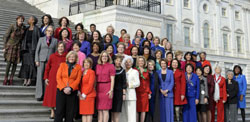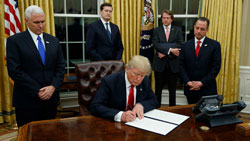According to a study by Politico, American University, and Loyola Marymount University, researchers Jennifer Lawless and Richard Fox found that, when asked “How qualified are you for public office,” only 22 percent of female participants answered “very qualified.”
Corey Wrenn, Ph.D., Director of the Gender Studies Program, explained the role that a woman’s confidence has both on herself and other women who may consider running for public office.
“Research finds that confidence is not just socialized but also situational, such that when we see women in positions of leadership, their communication style changes to fit the position,” she said. “The belief that women are not fit to lead is based on observations of women in general—who are not in leadership positions and thus…women are never even given the chance to lead.”
According to the PEW Research Center, in a 2014 study, when asked, “Why aren’t more women in top elective offices,” 47 percent of women agreed that it is because women are held to a higher standard than men are.
Lauren Santoro, an adjunct professor of political science, said that women who run for office face what has been termed the “double-bind,” having to display both femininity and masculinity, which is often associated with leadership. Santoro also notes the potential for women seeking office to face sexist commentary and other negative treatment. Things such as their appearance, their family life, and their “likeability” are questioned like that of no male candidate is.
Mary “Dee” Bulvanoski, an instructor of English, talked about how she faced similar treatment in her first campaign when she ran for the Board of Education in Oceanport, NJ.
“At the time I was a stay-at-home mother, and I definitely felt that two things worked against me: being female and not working outside of the home at the time,” she explained. “Fortunately, I had the opportunity to present a speech [which] allowed me to present my qualifications—including my position as a full-time mom—in a positive light, I was able to ‘turn the tide’ and felt that after that evening, there were more voters who had decided to take a chance on me,” she said.
“While I was campaigning, I felt a lot of negativity directed towards me because I was a woman running for the board. I think that there was one member of the standing board at the time who was a woman; the other eight members were men,” said Bulvanoski.
“During a follow-up question-and-answer session, some participants tried to point out my lack of skills in a ‘man’s position.’ For example, because the school was in the process of planning an addition to one of the buildings, one male questioner asked [what knowledge I had of] buildings and construction. I knew that I had to be careful when answering this; I did not want to come across as unqualified for a seat of the school board because I had had no previous experience in the building trades—as a man might be expected to have,” she continued.
“Fortunately, I answered by saying that I had no personal experience with construction, but as far as I knew I would not be expected to build anything—just hire people who knew what they were doing. My response took the sting out of the question and put the focus on the board member’s real job: to make good decisions and delegate appropriately,” she said. Bulvanoski said that her male opponents were not asked the same question.
In addition to facing sexist double standards in running for public office, Santoro noted that another issue that they face is, what is called, “the pipeline problem.” She explained that, until very recently, women would not enter politics until their families were raised. “Not until…members of a new generation of political women did we see women with young children holding national public office,” said Santoro.
“The other part of the pipeline problem is that women are underrepresented in pipeline professions, like being lawyers, business leaders, and political activists…thus dropping them out of the pipeline entering politics,” she explained.
Santoro also explained that, in the current politically-polarized environment, women are not often showing much observable difference compared with their male counterparts, but on certain issues that directly concern women, women in government work together. “This means that having women serving in government gives a voice to the concerns women have in terms of policy problems that need solving by government,” she said.
With only five percent of Black women currently being officeholders elected to statewide executive office, Congress, and state legislatures, they are an utterly under-represented group in politics and the policy-making process. Consequently, the voices and concerns of Black women are often left unheard.
“It is so important for women of color to be in political positions, because we represent a group that has been so badly marginalized to the point where our voices have begun to get suppressed,” said Esosa Ruffin, a sophomore political science and statistics student. “Who better can understand the problems faced by women of color than the group itself,” said Ruffin.
Currently, Black women only make up 4.1 percent of all Representatives in the House, and only one percent of all members in the Senate. Moreover, only 12 have ever held statewide elected executive offices, one being Sheila Oliver, who currently serves as New Jersey’s Lieutenant Governor. No Black woman has ever been elected as Governor of a state—though this statistic could have a historic change with Stacey Abrams, who is currently running in Georgia’s 2018 gubernatorial race.
In their report, “Girls Just Wanna Not Run,” Lawless and Fox surveyed college students and found that young men are more likely than young women to be socialized by their parents to think about politics as a career path, and young women are less likely than young men to receive encouragement to run for office.
Ruffin explained that, as a female political science student, she often does find that most of her classes are male-dominated. “Women should definitely be more exposed to politics, exposing them at a younger age could be a remedy,” she said. “I also think incorporating women’s history into the United States History classes in a more significant manner than just covering the Suffrage Movement could be advantageous for young females.”
“The good news is that things are changing. The record number of women running for office this year has been termed the ‘pink wave,’” said Santoro, noting the progress that women have made in politics.
As a result, many more young girls and women may now have a female politician to whom they aspire to be, something that Ruffin said is important to her, herself. “One of my biggest role models is California Senator Kamala Harris, who also happens to be one of my sisters in Alpha Kappa Alpha Sorority, Inc.,” she said. “Harris is a very influential political figure. She is unwavering in her positions on women’s rights and health issues, like affordable and accessible medical care, immigration policies which favor this country’s diversity, and racial inequality.”
Although that highest and hardest glass ceiling still looms over women who aspire to hold public office, thanks to generations of women making strides in politics, it has millions of cracks in it.
IMAGE TAKEN from MSNBC



